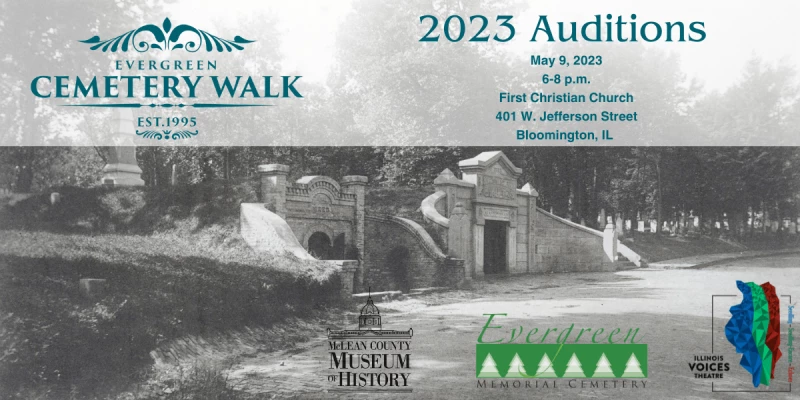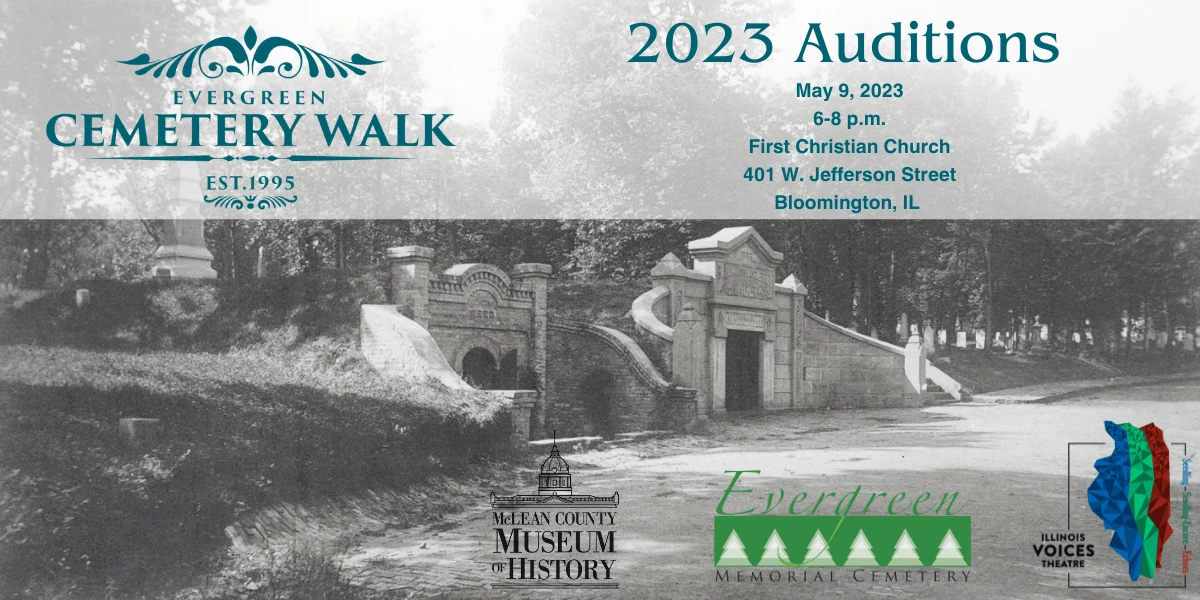Announcing auditions for the 2023 Evergreen Cemetery Walk!
Auditions will be held on Tuesday, May 9 from 6:00pm until 8:00 pm at First Christian Church, 401 W. Jefferson Street, Bloomington.
Performances for the Walk will be held at Evergreen Memorial Cemetery on the following dates:
Weekends: September 30, October 1 and October 7-8, 2023
School Tours: October 3-5, 2023
You must be available for weekday performance from 8:30-2 and weekends 10 – 4. There will be one day of filming for the Virtual Walk (Friday, October 6)
You will be asked to read from sides provided at the audition.
Performers at the Walk receive an honorarium for their time and talent.
Illinois Voices Theatre and the McLean County Museum of History are committed to equity, diversity, and inclusion. As such, we encourage performers or all races and ethnicities, gender identities, sexualities, and abilities to attend the audition. If you need special services, assistance, or appropriate modifications to fully participate in this event, please email Susan Thetard (Artistic Director of Illinois Voices Theatre Echoes) at echoes@ilvoicestheatre.org.
The characters portrayed this year are:
Paul Rhymer (1905-1964) a Bloomington High School graduate, was considered one of the great writers of the 1930s “script” radio shows with his popular “Vic and Sade,” which drew 7 million listeners for a show set in what was undeniably a fictionalized Bloomington. Prior to his radio days, Rhymer worked for the railroad, drove a cab, and was a reporter for the Pantagraph (where he was fired for fabricating stories). A practical joker, Rhymer was a private person despite his outgoing manner. He is visiting from Lexington Cemetery in honor of the recognition by the Bloomington Young Men’s Club for “Paul Rhymer Day” in 1938.
Samuel Noble (1834-1913) and Mary (Reed) King (1842-1928) were a force in the advancement of agriculture, and in the pursuit of educational and civic projects throughout Central Illinois. S. Noble was considered a “pioneer” farmer, particularly in the development of crop rotation practices and use of fertilizers. Mary (who had been an educator until her marriage) co-founded the McLean County Household Science Association, an organization that gave women educational opportunities to learn modern methods of household management. Upon his death, S. Noble deeded a generous part of his estate to underwrite the Jessamine Withers Home for Elderly Women, which was advanced by Mary with both her financial and personal involvement.
Francis Kessler (1887–1975) had a passion for music and education. Music had always been an interest in her life, and she credited her family for that love and appreciation of music. Each of her immediate family members played a musical instrument, with Kessler playing the piano. She received her teaching certificate from ISNU in 1907, a bachelors in music education from IWU, and a masters in music education from the American Conservatory of Music in Chicago. She was the first in the nation to teach music appreciation and to integrate radio in the classroom while teaching in Blooming public schools.
Annie Ethel Jones (1899–1991) was a Black woman born and reared on a Mississippi farm, which her family owned. She married an older man and they moved to Bloomington in 1922 to be near one of his daughters. Jones began working as a housekeeper but dreamed of becoming a doctor. Instead, she took a correspondence course to become an LPN, working first at St. Joseph’s Hospital, then the McLean County Poor Farm working with older adults. Later, she also did private nursing for families in the community. An active community member, Jones was involved with the NAACP and her church, Wayman AME.
Richard Blue (1842-1921) was born in Ohio and came to Bloomington at age 9 with Judge Rayburn and his family. Blue joined the Union Army in 1865, serving as a musician in the 29th U.S. Colored Infantry. After the Civil War, Blue worked as a janitor and door keeper for the Illinois General Assembly, was a barber in Bloomington, and was often a butler for large social events. He was heavily involved in community service and Black politics, including running for city alderman in Bloomington. Blue was also active in advancing Black literacy, helping start the “Bloomington Literary and Protective Association.”
John Jackson Mayes, Jr., (1851-1918) known as J.J., was engaged in the photography business, and had a reputation of being an artist with a camera. Canadian born, Mayes moved to the United States in about 1868, and two years later witnessed the “Great Chicago Fire.” By 1877, Mayes had moved to Bloomington and established a photography business with Albert Bell, eventually venturing out on his own and even teaching photography for a short time at IWU. He later went into the business of training and breeding racehorses, raising them in a barn he leased on Bloomington’s west side.

